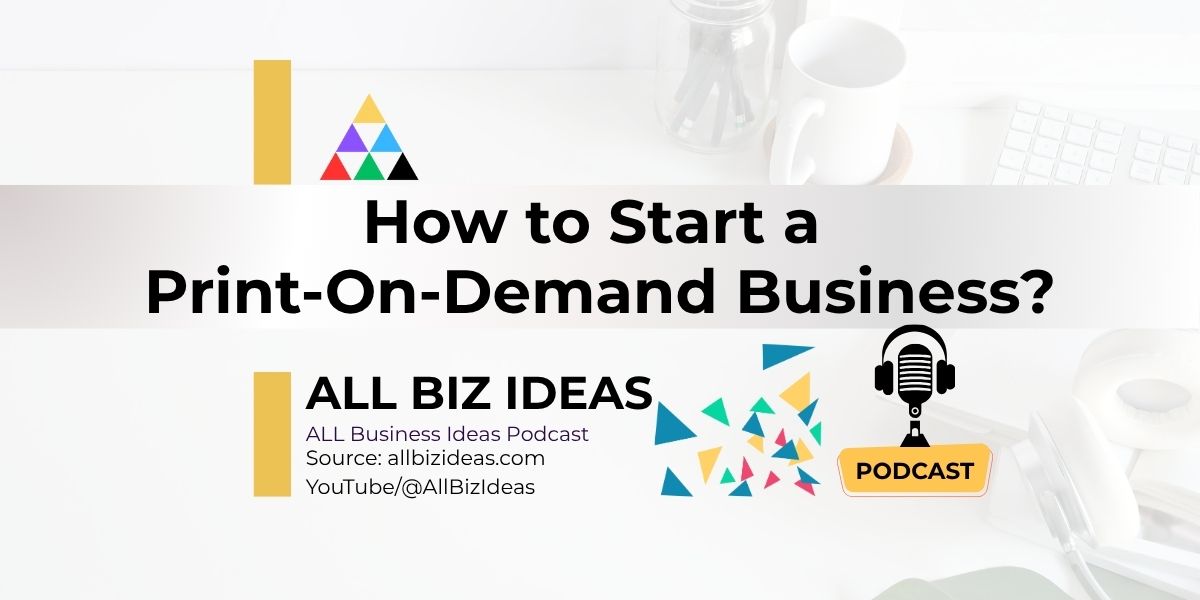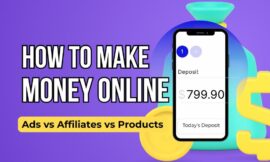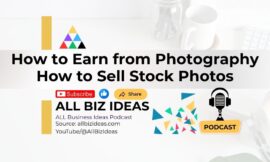How to Start a Print on Demand Business: Step-by-Step Guide to Launching Your Own Brand
Frequently Asked Questions
1. What is a Print on Demand (POD) business?
A Print on Demand business is an e-commerce model where custom products, such as t-shirts, mugs, and posters, are only produced and shipped to the customer once an order is placed. This eliminates the need for the seller to hold inventory. You create the designs, list the products on your online store, and when a customer buys, the print-on-demand platform handles the printing, packaging, and shipping directly to them.
2. What are the main advantages of starting a Print on Demand business?
The primary advantage is the low startup cost because you don’t need to invest in inventory upfront. Other benefits include significant flexibility, allowing you to work from anywhere with an internet connection, and scalability, as the fulfillment process is handled by the platform. It also offers creative freedom to turn your design ideas into physical products without the manufacturing complexities.
3. What are some common challenges faced in the Print on Demand business?
Despite the advantages, POD businesses face challenges. High competition, especially in popular niches, can make it difficult to stand out. Profit margins can be slim due to production and shipping costs. There is also a reliance on third-party platforms for fulfillment, meaning you have limited control over production quality and shipping times. Managing customer service, including returns and refunds, is still your responsibility.
4. How much does it typically cost to start a Print on Demand business?
Starting a POD business is relatively affordable. Estimated total startup costs can range from around $100 to $300, depending on your setup and marketing strategy. This can include costs for a domain name and hosting ($12–$100/year), an e-commerce platform subscription like Shopify (~$29/month), and potentially design software or hiring freelancers ($0–$200, one-time or ongoing). Initial marketing expenses can start from $50–$100.
5. Why is branding important for a Print on Demand business?
Branding is crucial for long-term success in the competitive POD market. A strong brand helps you stand out, builds trust with customers, and fosters loyalty, potentially leading to repeat business. It allows you to command higher prices than generic products and makes your business more scalable. Branding creates a memorable identity that resonates with your target audience.
6. What are the key steps to building a brand for a beginner in Print on Demand?
Building a brand as a beginner involves several steps: First, define your niche and target audience. Then, choose a memorable and relevant brand name and create a simple logo. Select consistent brand colors and fonts that reflect your brand’s tone. Develop a distinct brand voice for communication with customers. Organize your brand elements in a visual identity kit and create branded product mockups. Finally, launch your brand online with consistent profiles across social media and connect your store to a custom domain.
7. What are some effective marketing strategies for a Print on Demand brand?
Effective marketing is essential to reach your audience. Strategies include leveraging social media platforms like Instagram, TikTok, and Pinterest with visual content and customer testimonials. Content marketing through a blog or YouTube channel can establish authority and drive organic traffic via SEO. Email marketing is valuable for nurturing leads and promoting new products or offers. Partnering with influencers in your niche can provide exposure, and paid advertising on platforms like Facebook and Instagram allows for targeted reach.
8. What are some recommended platforms for starting a Print on Demand business?
Several platforms are available for starting a POD business. Printful is known for its high-quality products and seamless integration with platforms like Shopify, making it suitable for those focused on branding and scalability. Printify offers access to multiple suppliers, potentially providing better pricing options. Redbubble and TeePublic function as marketplaces, which can be a good starting point for beginners who may not have an existing audience as they handle traffic generation. Explore the in-depth step-by-step guide below.
Step-by-Step Guide: How to Start a Print on Demand Business
Step 1: Identify Your Niche
Choosing the right niche is crucial. Highly competitive niches include:
- Motivational fitness apparel
- Pet-themed clothing
- Political merchandise
Least competitive (yet promising) niches include:
- Hyper-local city pride designs
- Niche hobbies like urban gardening or mushroom foraging
- Professions like beekeepers or marine biologists
Your goal is to find a unique voice within a niche that has a passionate audience.
Step 2: Create Your Designs
If you’re not a designer, you can hire freelancers from platforms like Fiverr or Upwork. Tools like Canva, Adobe Illustrator, or Photoshop can help you make eye-catching designs.
Step 3: Choose a Print on Demand Platform
Some of the best platforms to start with include:
- Printful – Known for high-quality products and easy Shopify integration
- Printify – Offers multiple supplier choices for better pricing
- Redbubble & TeePublic – Marketplace models, great for beginners without an existing audience
Printful is often considered the best platform for those serious about branding and scalability due to its seamless integrations and global fulfillment centers.
Step 4: Build Your Store
Use Shopify, Etsy, or WooCommerce to host your online store. Shopify is user-friendly and integrates effortlessly with POD platforms like Printful.
Step 5: Upload Products & Set Pricing
Once your designs are ready, upload them to your chosen platform, write compelling product descriptions, and set your prices. Make sure to account for product cost, platform fees, and desired profit margins.
Step 6: Launch and Promote
Promote your products via:
- Social media marketing (Instagram, TikTok, Pinterest)
- Influencer partnerships
- Email marketing
- Paid ads
SEO is also critical – make sure your listings include relevant keywords like “funny gym shirt” or “custom cat mug.”
Opportunities in Print on Demand
- Low startup cost: No need to buy inventory upfront
- Flexibility: Work from anywhere with an internet connection
- Scalability: Once set up, you can automate and scale quickly
- Creative freedom: Turn your ideas into real-world products
Challenges You Might Face
- High competition: Especially in saturated niches
- Profit margins: Can be slim without volume
- Reliance on third parties: Fulfillment delays and quality control are out of your hands
- Customer service: You’ll still need to manage refunds, returns, and questions
Understanding these hurdles is essential when figuring out how to start a print on demand business successfully.
Cost to Start a Print on Demand Business
Starting a POD business is relatively affordable:
- Domain & Hosting: $12–$100/year
- E-commerce Platform (e.g., Shopify): ~$29/month
- Design Software or Freelancers: $0–$200 (one-time or ongoing)
- Marketing & Ads: Optional, but starting at $50–$100 can help
Estimated Total Startup Cost: Around $100–$300, depending on your setup and marketing strategy.
Action Plan: Launch in 30 Days
Week 1: Research & Plan
- Define your niche
- Research competitors
- Sign up on a POD platform (step 3) and e-commerce site (step 4)
Week 2: Create & Upload Products
- Design 10–15 products (Canva free)
- Write product descriptions (Keyword research)
- Set up branding and payment gateway (easily select payment gateway if using Shopify)
Week 3: Test & Launch
- Review and test your store
- Soft launch with friends or email list
- Set up basic analytics (use Google Analytics)
Week 4: Promote & Optimize
- Launch full-scale marketing campaign
- Start collecting feedback
- Tweak products and pricing based on sales
Key to Success: How to Start a Print on Demand Business | Branding Your Print on Demand Business.
Why Branding Matters in Your Print on Demand Business
If you’re serious about learning how to start a print on demand business, you can’t overlook the power of branding. In an increasingly saturated market, branding is what sets your business apart, builds trust with customers, and allows you to charge premium prices.
Why Create a Brand Instead of Selling Generic Designs?
While it’s tempting to upload random designs and hope something sticks, this approach rarely leads to long-term success. Here’s why building a brand is essential:
- Recognition: A brand creates a memorable identity that sticks with customers.
- Trust: People are more likely to buy from a brand they perceive as professional and consistent.
- Loyalty: Branding turns one-time buyers into repeat customers.
- Higher Margins: Strong brands can command higher prices than generic or unbranded products.
- Scalability: A cohesive brand is easier to grow, franchise, or even sell as a business later.
What Makes a Great POD Brand?
Successful POD branding involves more than just a cool logo. Here are the essential components:
- Unique Brand Name: Reflects your niche and mission
- Consistent Visual Identity: Logo, fonts, and color palette
- Strong Messaging: What your brand stands for and how it speaks to your target audience
- Branded Packaging (offered by some platforms like Printful)
- High-Quality Design Aesthetic: Consistency in tone and style across all products
Marketing Your Print on Demand Brand
Marketing is how you bring your brand to life and get it in front of the right audience. Here are proven marketing strategies:
1. Social Media Marketing
- Platforms like Instagram, TikTok, and Pinterest are goldmines for visual branding.
- Share lifestyle images, behind-the-scenes content, and customer testimonials.
2. Content Marketing
- Start a blog or YouTube channel to establish authority in your niche.
- Use SEO to drive organic traffic to your store.
3. Email Marketing
- Capture emails through pop-ups or discounts.
- Send newsletters, product drops, and special offers to drive repeat sales.
4. Influencer Marketing
- Partner with micro-influencers in your niche.
- Offer affiliate commissions or free merchandise in exchange for exposure.
5. Paid Advertising
- Use Facebook and Instagram Ads to target your ideal customers.
- A/B test creatives that align with your brand’s look and message.
Relevant Branding Approaches
- Niche-focused Branding: Tailor your brand identity tightly around a specific audience (e.g., dog lovers, nurses, gamers).
- Lifestyle Branding: Sell a lifestyle, not just a product. Think of brands that represent adventure, minimalism, or humor.
- Story-driven Branding: Share your brand’s origin story to create emotional connection.
Examples of Successful POD Brands
- Printy6’s Custom Galaxy – Known for vibrant galaxy-themed prints across clothing and accessories.
- Shadawear – A streetwear POD brand that blends graffiti art with urban culture.
- TeeTurtle – A POD-based brand that began with cute, geeky designs and scaled into plush toys, games, and licensed merchandise.
- BLK & Bold Coffee – Started as a small POD-style brand and expanded with mission-driven branding, later getting featured in major retailers.
These brands demonstrate how effective branding can take a small POD startup and grow it into a nationally recognized company.
How to Create a Brand for a Beginner (Especially for How to Start a Print on Demand Business)
Creating a brand isn’t just about a logo—it’s about crafting a complete identity that resonates with a specific group of people. Here’s how to get started:
Step 1: Define Your Niche and Audience
Before you even pick a name or design anything, ask:
- Who am I selling to? (e.g., dog lovers, nurses, anime fans)
- What are their interests, values, and problems?
- Why would they choose my brand over others?
Tip: The more specific your niche, the easier it is to build a recognizable brand.
Step 2: Choose a Brand Name
A good brand name should be:
- Memorable
- Easy to spell and say
- Relevant to your niche or vibe
- Available as a .com domain and on social media
Free tools to help:
- Namechk.com (checks domain + social availability)
- Shopify Business Name Generator
Step 3: Create a Logo
You don’t need to be a designer to create a professional-looking logo.
Options:
- Use Canva (free, beginner-friendly)
- Hire someone on Fiverr or Upwork (starting at $10–$25)
- Try Looka or Hatchful by Shopify for AI-generated logos
Keep your logo simple and scalable—it should look good on a phone, product label, or Instagram profile.
Step 4: Choose Your Brand Colors and Fonts
Choose 2–3 colors and 1–2 fonts that reflect your brand’s tone:
- Bold and energetic? Use reds, oranges, thick fonts.
- Calm and elegant? Use soft blues, greys, script fonts.
Use free tools like:
- Coolors.co (for color palettes)
- Google Fonts (for web-safe font choices)
Step 5: Develop Your Brand Voice
Your brand voice is how you “speak” to your customers. Decide if your tone is:
- Casual and playful (great for humor or meme-based brands)
- Empowering and bold (great for fitness or social justice)
- Calm and trustworthy (great for wellness or eco products)
Use this tone across product descriptions, social posts, emails, and ads.
Step 6: Build a Visual Identity Kit (Brand Kit)
This is a simple folder or document where you keep your:
- Logo
- Color hex codes
- Fonts
- Example social media post styles
- Mood board or visual references
Tip: Canva Pro allows you to create and save brand kits easily.
Step 7: Create Branded Product Mockups
Use your colors, logos, and style to make your POD product images feel consistent.
Tools:
- Placeit (easy mockup generator)
- Canva (for custom promotional images)
Step 8: Launch Your Brand Online
Set up branded profiles on:
- TikTok
Use your logo as your profile picture and keep your bio consistent across platforms.
Also, connect your store (like Shopify or Etsy) with a custom domain (e.g., www.YourBrandName.com).
Beginner Branding Tips
- Keep it simple at first—you can evolve over time.
- Be consistent: Use the same colors, tone, and style across everything.
- Focus on connection, not perfection—speak to your audience like a friend.
- Study successful POD brands to get inspired (e.g., TeeTurtle, INKspired Threads, or Feminist Apparel).
You Don’t Need to Be an Expert
If you’re just starting and wondering how to create a brand as a beginner, know this: the best brands grow with their audience. Start small, keep learning, and refine your branding as your business grows.
You don’t need to wait until everything is perfect. Your brand starts the moment you begin communicating with your future customers.
Final Thought on Branding and Scalability
When you’re exploring how to start a print on demand business, remember this: you’re not just selling t-shirts or mugs—you’re selling a brand experience. Branding gives your business long-term scalability, the potential to expand into new product lines, and the power to compete with larger e-commerce players.
If you want to build a business that lasts, start branding from day one. Invest time in your logo, your story, your audience, and your vision. The stronger your brand, the stronger your foundation for sustainable, scalable success.
Summary | How to Start a Print on Demand Business
- Print on Demand
- Difficulty Level: Moderate
- Resources Needed: Print-on-demand platforms (Printful, Teespring), design software (Adobe Illustrator, Canva)
- Skills Needed: Graphic design, branding, marketing
- Pros:
- No upfront inventory costs
- Creative freedom in designs
- Scalable
- Cons:
- Profit margins are relatively low
- Highly competitive market
- Relies heavily on marketing
Why This Business? Print-on-demand (POD) is an online business model where you create custom designs for products like t-shirts, mugs, and phone cases, and only print them when an order is placed. This model eliminates the need to hold inventory and offers entrepreneurs a chance to create unique, customized products. As an online business, POD is scalable and allows you to target niche markets by offering one-of-a-kind designs. With platforms like Printful and Teespring, getting started is easy and doesn’t require large investments.
Who Is This Business For? This business is ideal for individuals who are creative, have a passion for design, and enjoy marketing products online. It’s perfect for graphic designers or anyone with a flair for creating unique artwork. If you have a strong social media presence or understand how to leverage online marketing to reach niche audiences, POD can be an excellent income stream. It’s also great for people who want to start an e-commerce business without the hassle of inventory management or upfront costs.
How to Start a Print on Demand Business? To get started, create an online store through platforms like Shopify or Etsy and connect it to a print-on-demand service like Printful, Printify, or Gooten. Design your products using graphic design tools like Canva or Adobe Illustrator, or hire a designer to help bring your ideas to life. Once your products are ready, upload them to your online store and market them through social media, influencer collaborations, or ads. You only need to create designs and promote your store—when customers order, the print-on-demand service handles the printing and shipping.
Pros:
- Low startup costs (no need for inventory).
- Scalable and flexible business model.
- Opportunity for passive income with effective marketing.
- No need for physical storefronts or warehouse space.
Cons:
- Profit margins can be low due to printing and shipping costs.
- Highly competitive market.
- Relies heavily on marketing and traffic generation.
- Limited control over product quality and shipping times.
Conclusion: Start Your Print on Demand Journey Today
Now that you know how to start a print on demand business, it’s time to take action. This business model is ideal for creatives and entrepreneurs looking for flexibility, low risk, and a chance to build a recognizable brand.
While challenges exist, the opportunities far outweigh them if you take the time to understand your market, produce quality designs, and commit to smart marketing.
Ready to Build Your POD Empire?
Start by choosing your niche and signing up on a trusted platform like Printful or Printify. Whether you want to earn extra income or build a six-figure brand, starting a print on demand business could be your smartest move in 2025.
👉 Take your first step today and launch your POD store with Shopify in less than a month. The world is waiting for your designs.



